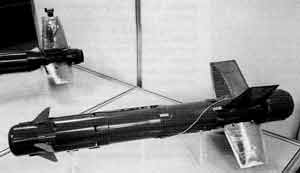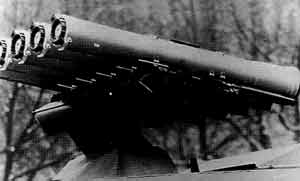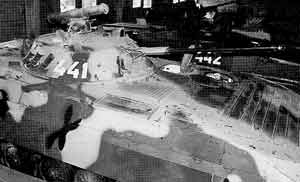| Designation: | 9M133 Konkurs/Spandrel |
 |
|---|---|---|
| Manufacturer: | KBP Instrument Design Bureau | |
| Product type: | Weapons & Weapon Systems | |
| Name: | Anti-tank guided missile launcher |
The system is designed to engage moving and stationary armoured targets provided with explosive reactive armour (ERA) protection.
The KONKURS-M system can be carried by armored wheeled and tracked wehicles.
The 9P135M1 launcher can be provided with a thermal imager for night or poor visibility conditions. When fitted with the thermal imager, which weighs 9.6 kg, it allows engagements at ranges up to 2500m. The launcher is designed to launch the 9M111, 9M111M, 9M113, and 9M113M missiles.
The 9M113M missile has a tandem warhead with an extended nose probe to defeat explosive reactive armour before the main warhead initiates to penetrate 750 to 800 mm of main armour. Missile has a semiautomatic control system with command transmission by wires.
Missiles are supplied in sealed containers placed directly on the launcher.
The US/NATO designated AT-5 'Spandrel' missile system (industrial index number 9K113, named Konkurs, meaning Contest) was developed by the Tula KBP Design Bureau for Instrument Building. It entered operational service in 1974 and is a second-generation heavyweight wire-guided tube-launched Semi-Automatic Command to Line Of Sight (SACLOS) vehicle- or ground-mounted Anti-Tank Guided Weapon (ATGW).
All the gunner has to do is to keep his day/night sight cross-hairs on the target until the missile impacts.
The 9P135 launch unit for ground use is the same as that used for the later versions of the AT-4 'Spigot' and identical interfaces allow the two missiles to be fired from the system.
The basic 9M113 missile (AT-5a 'Spandrel' is launched from a 1.263 m long GRP container-launcher tube. At the rear of the canister is a gas generator unit which ejects the missile from the tube; once clear the missile ignites a solid propellant sustainer rocket motor which vents its exhaust from two ventral ports. Missile stability in flight is provided by four gas-inflated thin metal fins which wrap around the missile body whilst in the launch container.
A 2.7 kg 9N131 HEAT warhead is fitted that can penetrate up to 600 mm of armour. Total weight of the canister with missile is 25.2 kg.
In the early 1990s the improved 9M113M Konkurs-M (AT-5b 'Spandrel') missile was revealed. This is fitted with a tandem HEAT warhead with an extensible standoff probe to defeat Explosive Reactive Armour (ERA) packages and is capable of penetrating up to 800 mm of conventional steel armour. A thermal night system has now been developed for the infantry version of the Konkurs which weighs 13 kg and enables targets to be engaged at night or under poor weather conditions from 75 to 2,500 m. This thermal imager is called the 1PN65 and is mounted above the missile in its launch tube.
The main launcher variants of the 9K113 system are given below.
- BMP-2 ICV, BMD-2 ACV and BMD-3 ACV
The 9K113 is. used on the BMP-2 and BMD-2 as the secondary armament with a fixed 9S428 guidance controller and launch system on the vehicle roof. An optical fire-control system, the 9Sh119M1, is integrated into the gunner's main BPK-1-42 fire-control system. Four rounds are carried which are used to load the launcher via the gunner's hatch, with the launcher traversed and folded to the vertical to accept the missile canister. The launcher system can also fire the shorter range 9M111 Fagot/Faktoria missiles. Bharat Dynamics Limited of India together with Euromissile have developed the Flame-V adaptor kit so that the MILAN 2 launcher tube can be fired from the Konkurs firing post (qv entry this section under India).
The BMD-3 ACV is believed to have a similar missile system arrangement.
- 9P137 (5-round) 4x4 wheeled tank destroyer
Based on the 4x4 BRDM-2 chassis, this two-man vehicle has a five-rail 9K113 launcher mounted on its roof. It has an automated reloading system which takes 25 seconds to reload all five rails.
An electro-optical tracker is mounted on the right side of the vehicle's superstructure. A warning system is fitted to alert the commander-gunner to any optical jamming that may occur. This allows him to switch to a simple manual wire-guidance mode if required. The 9P137 can only fire the 9M113 Konkurs family of missiles and carries a total of 14 9M113 missiles internally.
- 9P148 (5-round) 4x4 wheeled tank destroyer
The 9P148 is similar to the 9P137 vehicle but is configured to carry and fire both the 9M113 Konkurs and 9M111-2 Fagot missiles. A total of 10 rounds of each type is normally carried internally.
In production. In service with Afghanistan, Algeria, Bulgaria, Czech Republic, Hungary, India, Iraq, Poland, Russian Federation and Associated States (CIS), Slovakia and Syria.
- Tracked BMP-2 (single-tube turret launcher)
- BMD-1RD (single-tube turret launcher plus ground launcher)
- Tracked BMD-1P (single-tube turret launcher)
- Tracked BMD-2 (single-tube turret launcher)
- Tracked BMD-3 (single-tube turret launcher) Tracked BMP-1P (single-tube turret launcher)
- Tracked BMP-30 (single-tube turret launcher) (Bulgaria)
- Tracked BMP-23A (single-tube turret launcher) (Bulgaria)
- Tracked BMP-23 (single-tube turret launcher) (Bulgaria)
- 4x4 9P137 and 9P148 (BRDM-3 derivatives with five-tube launcher system) 4x4 Fahd 30 AFV (single-tube launcher) (Egypt).
Designed by the Tula KBP, (Design Bureau for Instrument Building).
Manufactured by the Degtaryev Machinery Plant in Kovrov, the Schit Machinery Plant in Izhevsk and the Tulskiy Armaments Plant in Tula. The 9M113 is licence-built by the Vazov Engineering Plant in Sopot, Bulgaria local manufacture; Bharat Dynamics Limited in India local manufacture; and, it is believed, by several other undisclosed countries. Recent information has indicated that this missile system is also built in Slovakia.
|
||||||||
|
|||||||||||||||||||||||||||










